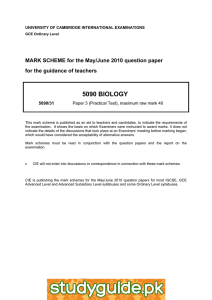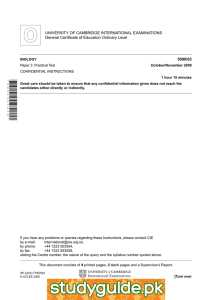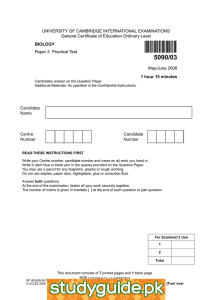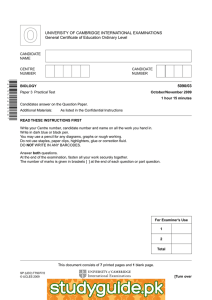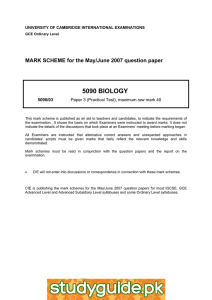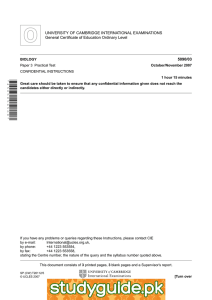UNIVERSITY OF CAMBRIDGE INTERNATIONAL EXAMINATIONS General Certificate of Education Ordinary Level 5090/13
advertisement
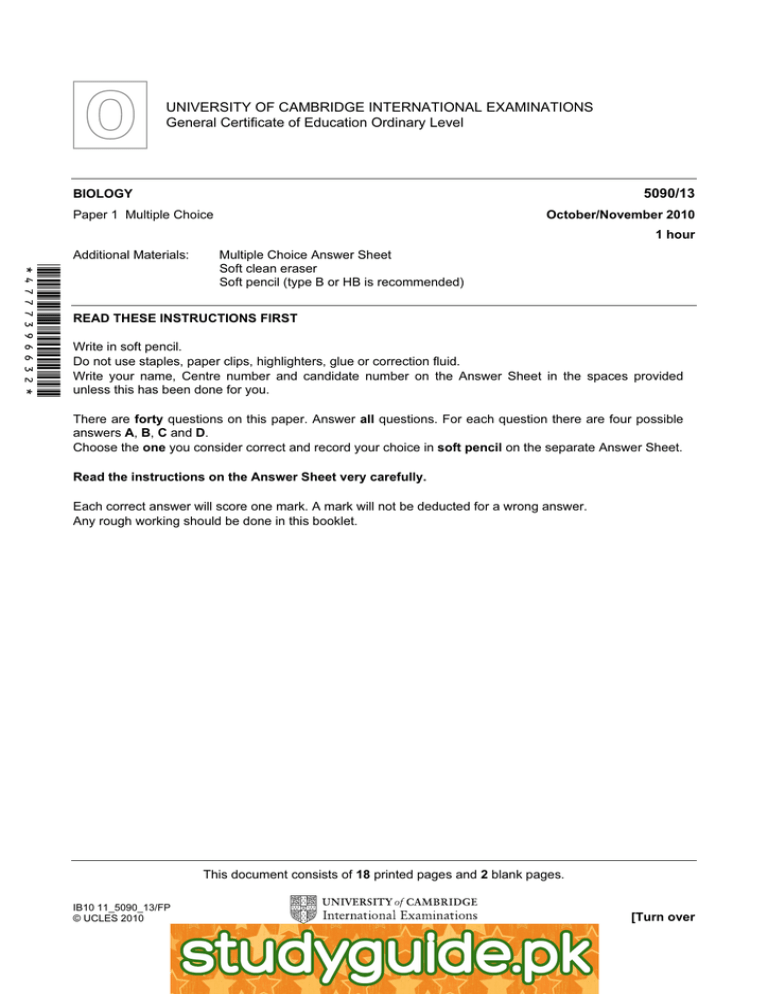
UNIVERSITY OF CAMBRIDGE INTERNATIONAL EXAMINATIONS General Certificate of Education Ordinary Level 5090/13 BIOLOGY Paper 1 Multiple Choice October/November 2010 1 hour Additional Materials: *4777396632* Multiple Choice Answer Sheet Soft clean eraser Soft pencil (type B or HB is recommended) READ THESE INSTRUCTIONS FIRST Write in soft pencil. Do not use staples, paper clips, highlighters, glue or correction fluid. Write your name, Centre number and candidate number on the Answer Sheet in the spaces provided unless this has been done for you. There are forty questions on this paper. Answer all questions. For each question there are four possible answers A, B, C and D. Choose the one you consider correct and record your choice in soft pencil on the separate Answer Sheet. Read the instructions on the Answer Sheet very carefully. Each correct answer will score one mark. A mark will not be deducted for a wrong answer. Any rough working should be done in this booklet. This document consists of 18 printed pages and 2 blank pages. IB10 11_5090_13/FP © UCLES 2010 [Turn over www.XtremePapers.net 2 1 The diagram represents the liver and associated blood vessels. 1 2 3 liver small intestine After a meal, how is the blood affected by the liver as it passes between these blood vessels? 2 blood vessels effect of liver A 2 to 1 glucose added B 2 to 1 urea removed C 3 to 1 glucose added D 3 to 1 urea removed The symptoms of a disease include weakness, fatigue, aching and swollen joints, bruise-like spots round the hair follicles and swollen and soft gums. Which food is used to treat this disease? 3 A liver as a source of iron B milk as a source of calcium C oily fish as a source of vitamin D D oranges as a source of vitamin C Which chemical test shows the presence of an enzyme in a biological washing powder? A Benedict’s B biuret C ethanol emulsion D iodine solution © UCLES 2010 5090/13/O/N/10 www.XtremePapers.net 3 4 Vitamin C changes cholesterol into a form which is less likely to be deposited in artery walls. Which dietary advice would help prevent coronary heart disease? 5 6 A Eat more bread and less meat. B Eat more butter and less bread. C Eat more meat and less oranges. D Eat more oranges and less butter. Which terms describe the parts of a plant? leaf leaf mesophyll leaf epidermis A organ cell tissue B organ tissue tissue C organ system tissue cell D tissue cell cell The diagram shows part of a flowering plant. Where does most transpiration take place? A upper surface of leaf B lower surface of leaf D stem C root © UCLES 2010 5090/13/O/N/10 www.XtremePapers.net [Turn over 4 7 8 Which adaptations of a root hair cell make it suitable for water uptake? partially permeable cell membrane surface area to volume ratio of the cell A absent high B absent low C present high D present low The diagram shows a root hair. 1 2 Which arrows show the direction in which it is possible for nitrate ions and water molecules to move? nitrate ions water molecules A 1 only 1 and 2 B 1 and 2 1 and 2 C 1 and 2 2 only D 2 only 1 only © UCLES 2010 5090/13/O/N/10 www.XtremePapers.net 5 9 A freshly picked leaf is placed in a sealed test-tube with some hydrogen carbonate indicator solution. The tube is kept in the light during the day. The indicator changes colour as shown. leaf hydrogen carbonate indicator colour amount of carbon dioxide compared to average atmospheric concentration purple less than normal red normal yellow more than normal Which colour will the hydrogen carbonate indicator be at midday and at midnight? at midday at midnight A purple yellow B red purple C yellow purple D yellow red 10 The graph shows the effect of light intensity on the rate of photosynthesis. rate of photosynthesis / arbitrary units 0 0 light intensity Which statement could explain what is happening at higher light intensities? A All the available chloroplasts are fully occupied in light absorption. B High light intensities increase the temperature above the optimum for photosynthesis. C The chlorophyll in the chloroplasts has been damaged. D The products of photosynthesis accumulate and inhibit photosynthesis. © UCLES 2010 5090/13/O/N/10 www.XtremePapers.net [Turn over 6 11 Nitrates in the soil can be absorbed by plants. Nitrates can also be removed from the soil by the action of A bacteria in the root nodules of legumes. B denitrifying bacteria in poorly aerated conditions. C nitrogen-fixing bacteria on ammonium compounds. D nitrogen-fixing bacteria on decaying plants. 12 Lack of nitrate ions (NO3–) in flowering plants causes yellowing of leaves and poor growth whereas lack of magnesium ions (Mg2+) causes yellowing between veins of leaves. What explains these differences? Mg2+ NO3– involved in chlorophyll synthesis involved in protein synthesis involved in chlorophyll synthesis involved in protein synthesis A key B = true C = not true D © UCLES 2010 5090/13/O/N/10 www.XtremePapers.net 7 13 Which graph shows the effect of temperature on enzyme-controlled reactions? A B rate of reaction / arbitrary units rate of reaction / arbitrary units 0 10 20 30 40 50 0 60 10 20 30 40 temperature / °C temperature / °C C D rate of reaction / arbitrary units 50 60 50 60 rate of reaction / arbitrary units 0 10 20 30 40 50 0 60 10 temperature / °C 20 30 40 temperature / °C 14 Four identical pieces of potato are treated in two stages, as shown. Which piece of potato will be largest after 2 hours? stage 1 stage 2 A boiled in water for 10 minutes placed in 10 % salt solution for 2 hours B boiled in water for 10 minutes placed in distilled water for 2 hours C unboiled placed in 10 % salt solution for 2 hours D unboiled placed in distilled water for 2 hours © UCLES 2010 5090/13/O/N/10 www.XtremePapers.net [Turn over 8 15 The diagram shows the structures associated with a human kidney. X Y Z vena cava aorta What are the relative concentrations of urea in X, Y and Z? A X is sometimes higher than Y B Y is always higher than Z C Y is always lower than Z D Z is sometimes lower than X 16 Which sequence shows the shortest route taken by blood travelling from a leg to an arm in the human body? A leg → heart → lungs → heart → arm B leg → heart → lungs → kidney → arm C leg → kidney → heart → lungs → arm D leg → lungs → heart → gut → arm © UCLES 2010 5090/13/O/N/10 www.XtremePapers.net 9 17 The diagram shows a section through skin. vessel X sweat gland What happens if the body temperature starts to fall below normal? sweat glands blood flow in vessel X A secrete sweat decreases B secrete sweat increases C stop secreting sweat decreases D stop secreting sweat increases 18 The diagrams show two kinds of fruit. fleshy, colourful fruits (×1) (×5) 1 2 How are the seeds of these fruits dispersed? 1 2 A birds mammals B birds wind C mammals birds D wind mammals © UCLES 2010 5090/13/O/N/10 www.XtremePapers.net [Turn over 10 19 What passes down a pollen tube after pollination? A female nucleus B male nucleus C ovule D pollen grain 20 The following changes take place in an athlete’s body during a 100 m race. Which change occurs first? A increased availability of oxygen to muscles B increased breathing rate C increased carbon dioxide concentration in the blood D increased production of carbon dioxide by muscles 21 The diagram shows an experiment to study respiration in growing barley seeds. at the start of the experiment dead, sterile barley seeds after four hours at the start of the experiment growing barley seeds vacuum flask cotton wool plug thermometer The results of this experiment show that respiration A produces carbon dioxide. B releases energy. C requires glucose. D uses up oxygen. © UCLES 2010 5090/13/O/N/10 www.XtremePapers.net after four hours 11 22 What happens to the muscles of the diaphragm, the external intercostal muscles and the position of the diaphragm when breathing in? diaphragm muscles external intercostal muscles diaphragm movement A contract contract downward B contract relax upward C relax contract upward D relax relax downward 23 The diagram shows a blood capillary close to some tissue cells bathed in tissue fluid. Exchange of nutrients takes place here. direction of blood flow plasma red blood cell capillary walls cell tissue fluid Which row shows the type of nutrient in the plasma and in the tissue fluid and the method of transfer between the two? plasma tissue fluid method of transfer A amino acid amino acid diffusion B amino acid protein osmosis C protein amino acid digestion D protein protein active uptake © UCLES 2010 5090/13/O/N/10 www.XtremePapers.net [Turn over 12 24 The diagram shows some nerve pathways involved in temperature control of the human body. X muscle layer temperature receptor blood vessel sweat gland surface of skin Which part of the nervous system does X represent? A cerebrum B hypothalamus C medulla D pituitary gland © UCLES 2010 5090/13/O/N/10 www.XtremePapers.net skin 13 25 The diagram shows a section through the human brain. W Y X What are the functions of the labelled regions? memory balance A W X B W Y C X W D X Y 26 The graph shows how the diameter of the pupil of a person’s eye changed during the course of two minutes. pupil diameter X 0 1 2 time / minutes What happens to the light intensity at X and which muscles begin to contract? light intensity iris muscles contracting A decreases circular B decreases radial C increases circular D increases radial © UCLES 2010 5090/13/O/N/10 www.XtremePapers.net [Turn over 14 27 The diagram shows a section through the female reproductive system. X Y Z During pregnancy, where does mitosis occur in the cells of the embryo? X Y Z A key B = takes place C = does not take place D 28 What is a reason for breast milk being better for a baby than bottled milk? A It contains antibodies for disease protection. B It contains calcium ions for bone development. C It contains protein for growth. D It contains sugar for energy. 29 What makes the female mosquito an effective vector for malaria? A It has wings. B It lays many eggs. C It makes a noticeable noise. D It mates several times. 30 Which organisms are used, and what is their role, in the manufacture of cheese? organism role A bacteria to lower the pH B fungi to break down milk sugar C viruses to curdle milk D yeast to release carbon dioxide © UCLES 2010 5090/13/O/N/10 www.XtremePapers.net 15 31 When are antibiotics likely to be most effective? A Infection is caused by a bacterium or fungus. B Infection is caused by a virus. C The disease is cancerous. D The pathogen can digest the antibiotic. 32 The diagram shows part of the nitrogen cycle. nitrogen in plants P nitrogen in animals Q S nitrates R ammonium compounds Which stages depend on bacteria? A P, Q, R and S B P and S only C Q and R only D R and S only 33 A single plant provides food for many herbivores. The herbivores supply food for a few carnivores. pyramid of numbers W pyramid of biomass X Y Z Which pyramid of numbers and which pyramid of biomass show this information? pyramid of numbers pyramid of biomass A W Y B W Z C X Y D X Z © UCLES 2010 5090/13/O/N/10 www.XtremePapers.net [Turn over 16 34 Lichens are organisms which are very sensitive to air pollution. The graph shows how the distance from a coal-fired power station affects the number of different types of lichen growing. 40 number of different types of lichen 20 growing 0 0 4 8 12 distance from power station / km 16 Which conclusion can be drawn from this information? A Lichens grow faster near the power station. B Lichens grow more slowly near the power station. C Sulfur dioxide from the power station inhibits the growth of lichens. D There are fewer different types of lichen growing near the power station. 35 The inheritance of the ABO blood groups in humans is controlled by three alleles (IA, IB and IO), only two of which can be present in one individual. What are the possible blood groups of children born to a homozygous group A woman and a heterozygous group B man? A A and B only B A and AB only C A, B and AB only D A, B, AB and O 36 The genotype for the height of an organism is written as Tt. What conclusion may be drawn? A The allele for height has at least two different genes. B There are at least two different alleles of the gene for height. C There are two different genes for height, each having a single allele. D There is one allele for height with two different forms. © UCLES 2010 5090/13/O/N/10 www.XtremePapers.net 17 37 The body cells of a mammal contain two copies of 24 000 genes, making 48 000 genes in total. Of these 48 000 genes in the body cells of a mammal, how many would have been inherited from its mother? A 6 000 B 12 000 C 24 000 D 48 000 38 Which statement is evidence that genes may be copied and passed on to the next generation? A Asexual reproduction produces genetically identical offspring. B Different alleles of a gene can produce variation in phenotype. C Each species of a plant or animal has a fixed number of chromosomes. D Sexual reproduction produces genetically different offspring. © UCLES 2010 5090/13/O/N/10 www.XtremePapers.net [Turn over 18 39 The diagram shows part of a river into which sewage is being pumped. Some of the effects of adding sewage to the river are plotted in the graph. sewage pumping station 1 2 river 4 3 W relative amount / arbitrary units X Y Z 1 2 3 4 position along river Which graphs represent the bacteria and the oxygen content of the water? bacteria oxygen A W Y B X Z C Y X D Z W 40 Which bones meet at the elbow joint and what kind of movement do they allow? bones movement A humerus and scapula in one plane only B humerus and scapula in three planes C ulna and humerus in one plane only D ulna and humerus in three planes © UCLES 2010 5090/13/O/N/10 www.XtremePapers.net 19 BLANK PAGE © UCLES 2010 5090/13/O/N/10 www.XtremePapers.net 20 BLANK PAGE Permission to reproduce items where third-party owned material protected by copyright is included has been sought and cleared where possible. Every reasonable effort has been made by the publisher (UCLES) to trace copyright holders, but if any items requiring clearance have unwittingly been included, the publisher will be pleased to make amends at the earliest possible opportunity. University of Cambridge International Examinations is part of the Cambridge Assessment Group. Cambridge Assessment is the brand name of University of Cambridge Local Examinations Syndicate (UCLES), which is itself a department of the University of Cambridge. © UCLES 2010 5090/13/O/N/10 www.XtremePapers.net
